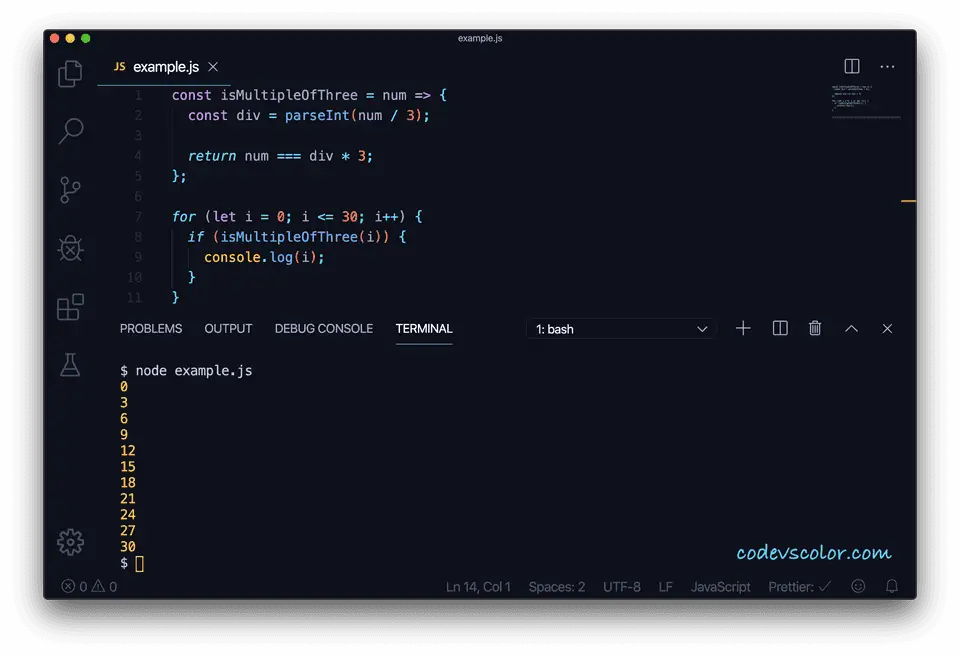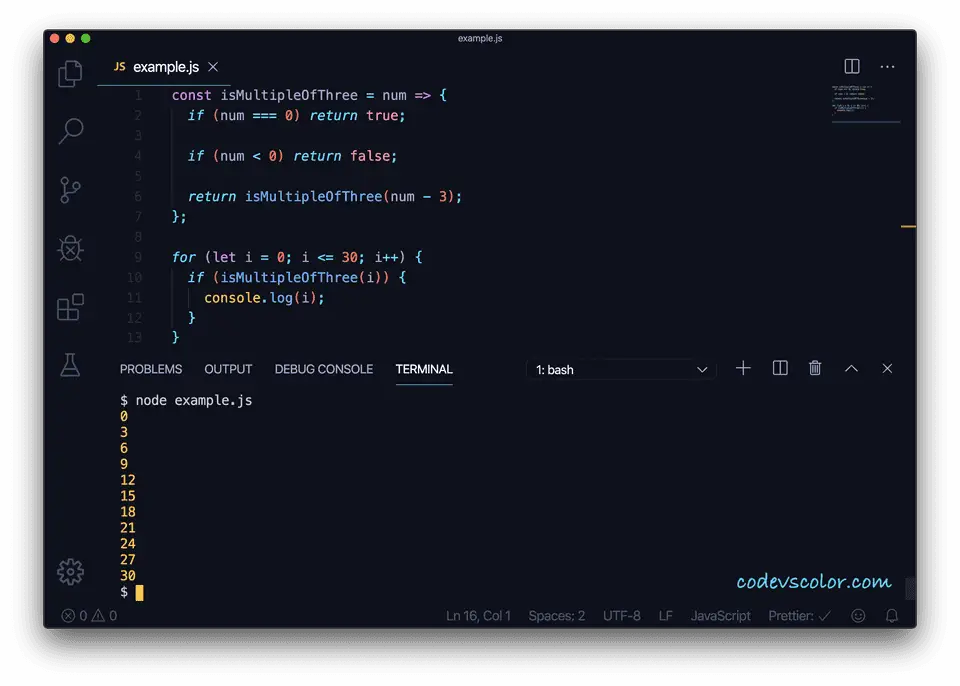Introduction :
In this post, I will show you three different ways to check if a number is divisible by 3 or not without using the modulo % operator. For each example, we will use one for loop to iterate from 0 to 30 and print out the numbers that are divisible by 3.
Method 1: With divide and multiply:
This method will use the following steps:
- Divide the number by 3
- Convert this value to an
integer - Multiply the result by 3 and check if it is equal to the original number or not.
For example, if the number is 21:
- The result of 21/3 is 7.
- The integer value of 7 is 7.
- If you multiply 7 by 3, it will be 21 i.e. equal to the original number. So, 21 is divisible by 3.
If the number is 32:
- The result of 32/3 is 10.666666666666666.
- The integer value of the result is 10.
- If you multiply 10 by 3, it will be 30, which is not equal to the original number. So, 32 is not divisible by 3.
JavaScript Program:
The following program uses the above approach:
const isMultipleOfThree = (num) => {
const div = parseInt(num / 3);
return num === div * 3;
};
for (let i = 0; i <= 30; i++) {
if (isMultipleOfThree(i)) {
console.log(i);
}
}Download it on GitHub
Explanation :
- The above program uses one
forloop to iterate over the numbers from 0 to 30. - It calls the
isMultipleOfThreemethod to check if the current value ofiis divisible by 3 or not.- The
parseIntmethod is used to get the integer value of the divisionnum/3. This value is assigned to the variablediv. - The
isMultipleOfThreemethod returnstrueif the original number is equal to the multiplication ofdivand 3. Else, it returnsfalse.
- The
- If the return value of
isMultipleOfThreeistrue, it prints that value ofi.
Output:
If you run this program, it will print all the multiples of 3 between 0 to 30:
0;
3;
6;
9;
12;
15;
18;
21;
24;
27;
30;Method 2: With a recursive function:
This is a recursive approach to check if a number is divisible by 3 or not. It will keep subtracting 3 from the original number until it becomes zero or less than zero. If it becomes zero, that number is divisible by 3. And if it is less than zero, it is not.
JavaScript Program:
The following program uses a recursive function to check if a number is divisible by 3 or not:
const isMultipleOfThree = (num) => {
if (num === 0) return true;
if (num < 0) return false;
return isMultipleOfThree(num - 3);
};
for (let i = 0; i <= 30; i++) {
if (isMultipleOfThree(i)) {
console.log(i);
}
}Download it on GitHub
Explanation:
- The
isMultipleOfThree_is a recursive method. - This method subtracts 3 from the number argument and calls itself again recursively.
- If at any point, the argument becomes zero, it returns
true. If it becomes negative, it returnsfalse. - It uses a
forloop from 0 to 30 and prints out the multipliers of 3.
It will print the below output:
0;
3;
6;
9;
12;
15;
18;
21;
24;
27;
30;Method 3: By finding the digit sum:
If a number is divisible by 3, the sum of its digits should be divisible by 3. For example, the sum of digits for 1236 is 1 + 2 + 3 + 6 = 12 = 1 + 2 = 3, which is divisible by 3. So, 1236 is also divisible by 3.
We will write one function to find out the sum of the digits of a number. The main function will call this function. If the sum is 3, 6, or 9, the number will be divisible by 3.
JavaScript Program:
const sumDigits = (num) => {
let sum = 0;
while (num) {
sum += num % 10;
num = Math.floor(num / 10);
if (num == 0 && sum > 9) {
num = sum;
sum = 0;
}
}
return sum;
};
const isMultipleOfThree = (num) => {
let sumOfDigits = sumDigits(num);
return (
sumOfDigits === 0 ||
sumOfDigits === 3 ||
sumOfDigits === 6 ||
sumOfDigits === 9
);
};
for (let i = 0; i <= 100; i++) {
if (isMultipleOfThree(i)) {
console.log(i);
}
}Download it on GitHub
- The
sumDigitsmethod finds the sum of the digits of a number. It will keep adding the digits until it becomes a single-digit number. For example, the sum of digits of 66 is 12. But, since 12 is a two-digit number, it will again find the sum of the digits of 12, which is 3. - The
isMultipleOfThreemethod calls thesumDigitsmethod to find the sum of digits of a number. If the return value is 0, 3, 6, or 9, it will be divisible by 3. - The
forloop runs from 0 to 100 and for each number it calls the isMultipleOfThree method and prints the multipliers of 3.
Output:
This program will print the below output:
0
3
6
9
12
15
18
21
24
27
30
33
36
39
42
45
48
51
54
57
60
63
66
69
72
75
78
81
84
87
90
93
96
99It prints the multipliers of 3 in between 0 to 100.
Similar tutorials :
- How to remove element from an array in Javascript
- How to reverse a string in Javascript in one line
- How to check if a number is perfect or not in Javascript
- 3 different ways in Javascript to find if a string contains a substring or not
- Create one number comparison application in JavaScript
- How to add and delete last and first elements in a JavaScript array



